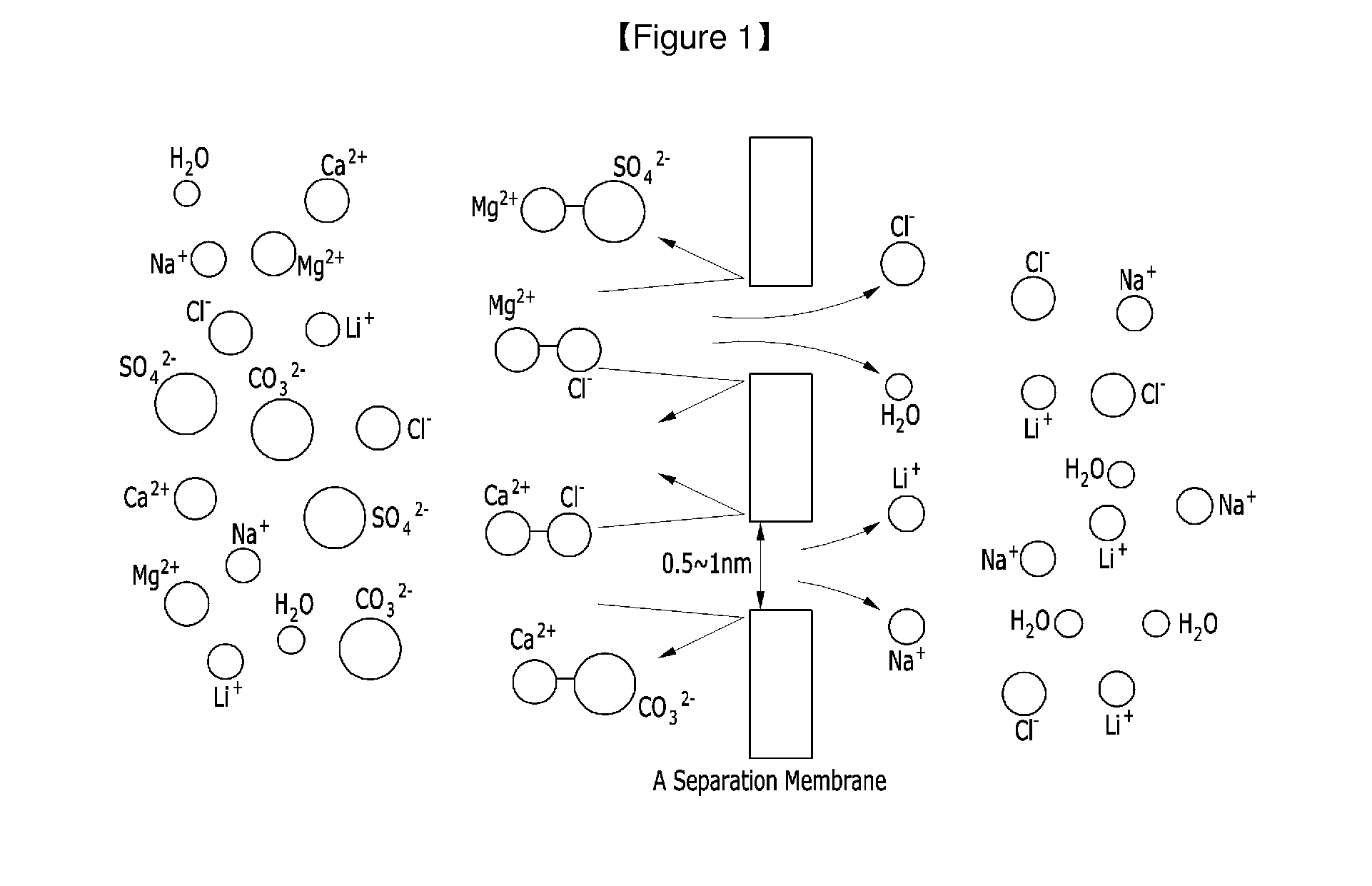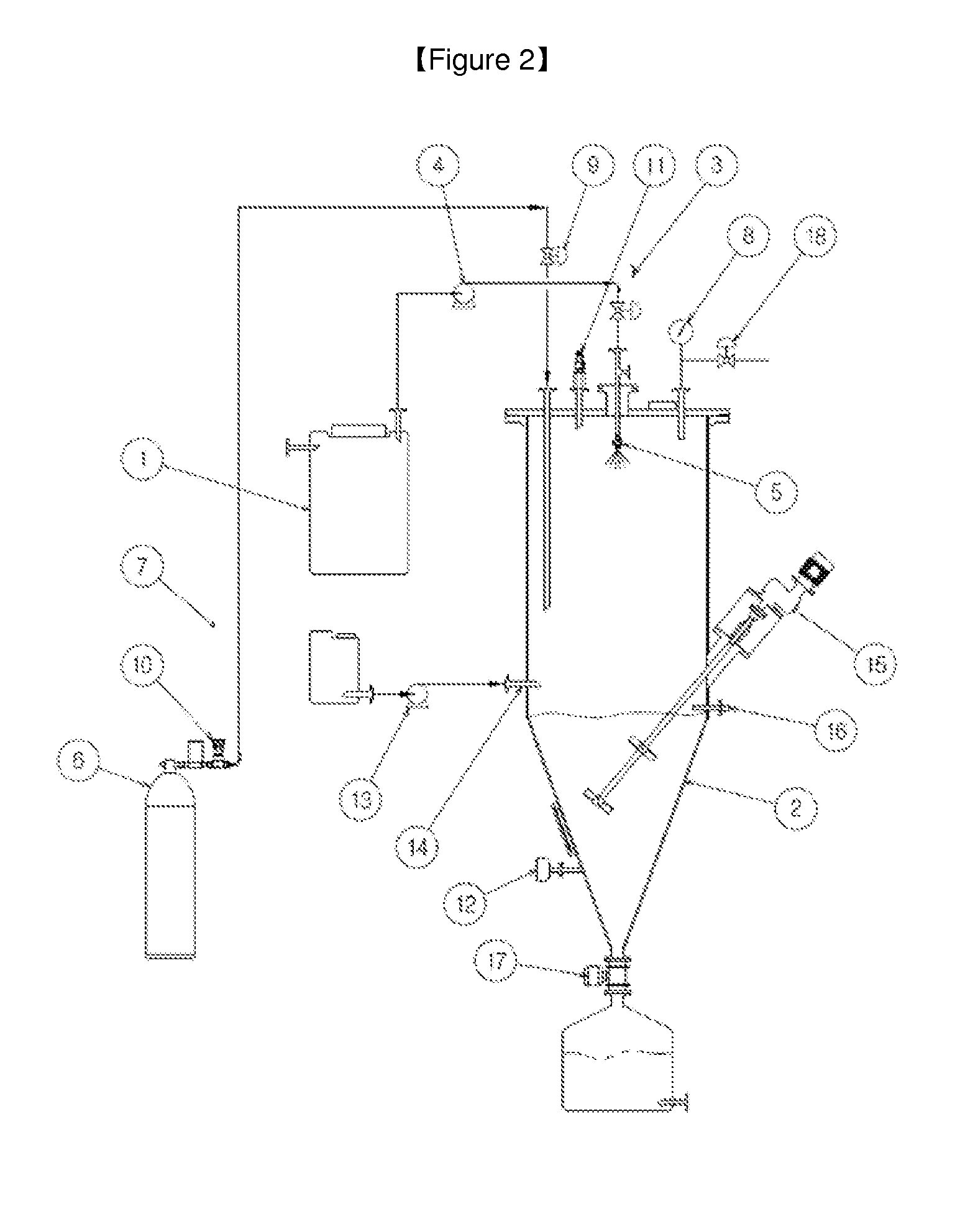Method for Extracting Lithium from Solution Containing Lithium
a lithium and solution technology, applied in the field of extracting lithium from a solution, can solve the problems of high cost of process, severe environmental pollution, uneconomical direct extraction of lithium from seawater, etc., and achieve the effect of minimizing material generation and low cos
- Summary
- Abstract
- Description
- Claims
- Application Information
AI Technical Summary
Benefits of technology
Problems solved by technology
Method used
Image
Examples
example 1
Separation of Monovalent Ions Using Separation Membrane
[0287]Brine having the following composition was prepared and then separated using a separation device including a separation membrane having anions. The separation membrane was SR100 made by Coach Corporation.
[0288]The following Table 1 shows a composition change of the brine before and after passing through the separation membrane.
TABLE 1IonsMgCaNaKLiBSO4ClBrine before968052078,7408701110044725,600 151,200treatmentBrine after403031575,070880011004185,120154,490treatment
[0289]As shown in Table 1, Mg2+ and Ca2+ had a sharply decreased concentration due to the separation membrane. In addition, SO42− ions had a sharply decreased concentration.
[0290]On the contrary, the concentration of monovalent ions was not changed much.
example 2
Surface Charge of Magnesium Hydroxide Depending on pH
[0291]NaOH was added to brine including 20,000 ppm of magnesium ions, 900 ppm of boron ions, 350 ppm of calcium ions, and 900 ppm of lithium ions to adjust pH of the brine and precipitate magnesium hydroxide. The precipitated magnesium hydroxide was measured regarding surface charge. The results are provided in FIG. 5.
[0292]As shown in FIG. 5, when the brine including the NaOH added thereto has pH ranging from 8.5 to 10.5, magnesium hydroxide maintained positive charges (+) on the surface. Accordingly, the magnesium hydroxide co-precipitated magnesium and boron from the brine and effectively extracted the magnesium and boron as well as easily adsorbed boron anions but not lithium cations, and thus minimized lithium loss.
example 3
Impurities Depending on pH
[0293]Magnesium hydroxide was precipitated by changing pH of the brine including 20,000 ppm of magnesium ions, 900 ppm of boron ions, 350 ppm of calcium ions, and 900 ppm of lithium ions. The precipitated magnesium hydroxide was filtered and separated from the brine. The remaining solution after filtration was measured regarding each amount of magnesium, boron, and lithium. The results are respectively provided in FIGS. 6, 7, and 8.
[0294]FIG. 6 provides data of a Mg concentration in the filtered solution depending on pH, FIG. 7 provides data of a B concentration in the filtered solution depending on pH, and FIG. 8 provides data of a Li concentration in the filtered solution depending on pH.
[0295]As shown in FIG. 6, the pH of the brine was not much changed even though the addition of the NaOH was initially increased, since OH ions were consumed to produce the magnesium hydroxide. However, when the NaOH was increasingly added, the amount of magnesium in the f...
PUM
| Property | Measurement | Unit |
|---|---|---|
| pore size | aaaaa | aaaaa |
| thickness | aaaaa | aaaaa |
| pH | aaaaa | aaaaa |
Abstract
Description
Claims
Application Information
 Login to View More
Login to View More - R&D
- Intellectual Property
- Life Sciences
- Materials
- Tech Scout
- Unparalleled Data Quality
- Higher Quality Content
- 60% Fewer Hallucinations
Browse by: Latest US Patents, China's latest patents, Technical Efficacy Thesaurus, Application Domain, Technology Topic, Popular Technical Reports.
© 2025 PatSnap. All rights reserved.Legal|Privacy policy|Modern Slavery Act Transparency Statement|Sitemap|About US| Contact US: help@patsnap.com



